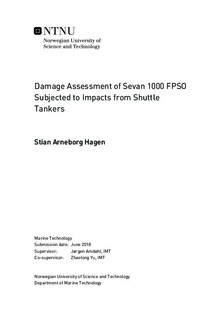| dc.description.abstract | Floating, production, storage and offloading (FPSO) units are the only viable option for oil and gas production in deep waters. Shuttle tankers are normally employed for cargo transfer because they are the most practical solution in remote fields. Cargo offloading can be performed in a tandem configuration where the shuttle tanker is positioned a distance behind the FPSO. During the long-lasting offloading process, various types of failures may result in drive-off and drift-off impact scenarios. Collisions between shuttle tankers and FPSOs are fortunately rare events, but in the case of an accident, the outcome can be catastrophic.
The cylindrical Sevan FPSO concept is designed with respect to i.a. motion characteristics and structural resistance to potential impacts. In this thesis, the damage in the Sevan 1000 FPSO when subjected to impacts from a 150,000 deadweight tonnage shuttle tanker and two types of supply vessels was studied. The emphasis was on shuttle tanker impacts. The objective was to determine the energy dissipation involved in drive-off impacts and to study the relative strength and the local structural response in the striking ship and the struck FPSO.
Impact scenarios were defined by upper limit drive-off velocities and drafts corresponding to the initial and final offloading phase. Both head-on and glancing (non-central) impacts were studied for each scenario. A finite element model of the Sevan 1000 FPSO was created in the software Sesam GeniE and imported into the numerical code LS-DYNA for non-linear finite element analysis.
A decoupled approach was applied for assessment of shuttle tanker impacts, which means that external rigid body dynamics and local structural deformations are studied separately. It was found from analysis of central impacts that the maximum dissipated energy is 204 MJ in the initial offloading phase and 147 MJ in the final offloading phase. For non-central impacts, it was observed that the reduction of energy dissipation is highly affected by the impact angle and a sticking-sliding mechanism, where sliding between the bodies leads to the largest reduction. For supply vessel impacts, the maximum dissipated energy was 15 MJ and 58 MJ when the initial velocity was 2 m/s and 4 m/s, respectively.
From the assessment of local structural response, it was observed that application of a shared-energy design is essential in analysis of shuttle tanker FPSO collisions. It was found that the relative strength is dependent on the offloading phase due to draft variations. In the initial offloading phase, the shuttle tanker forecastle was crushed by the FPSO superstructure, while in the final offloading phase, the FPSO bilge box was crushed by the bulbous bow of the shuttle tanker. In summary, the main hull of the FPSO is still intact after a drive-off impact, but ruptures can occur in the bilge box and in the superstructure in specific scenarios.
Glancing supply vessel impacts were studied using a coupled model in LS-DYNA which included hydrodynamic effects. From the coupled analysis, it was found that significant pitch and yaw motions in the striking vessel were generated by the collision process. The intensity of each component depends on the glancing impact angle. For larger angles, it was observed that the importance of frictional energy increased, thus the share of strain energy absorption will be further reduced. | |

